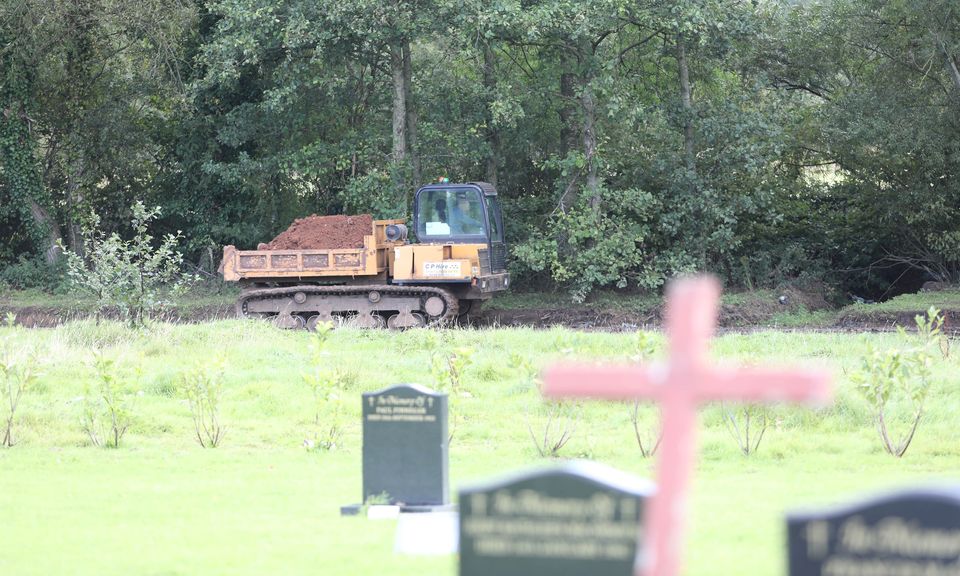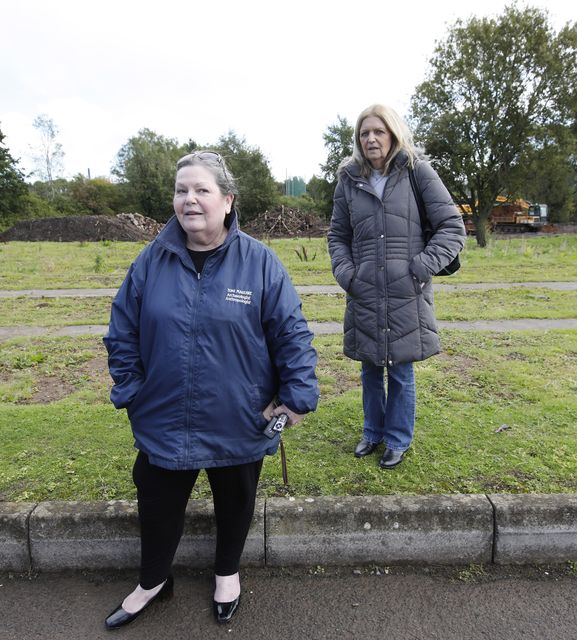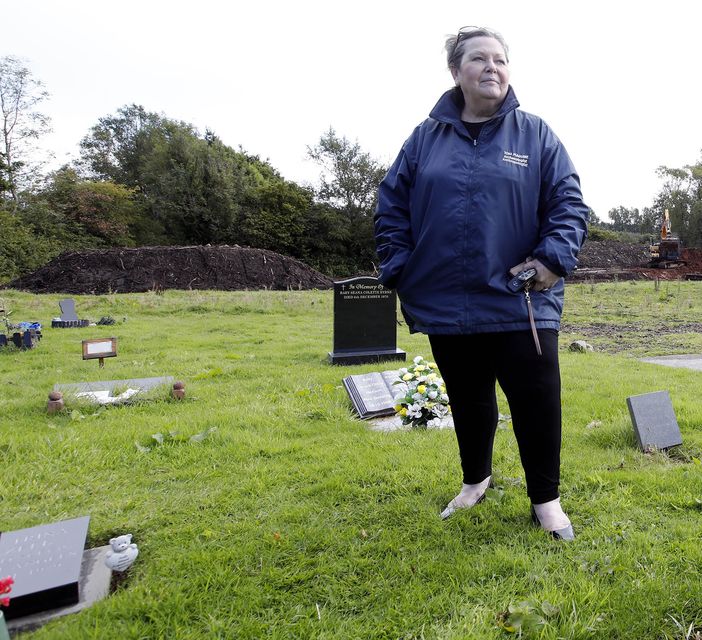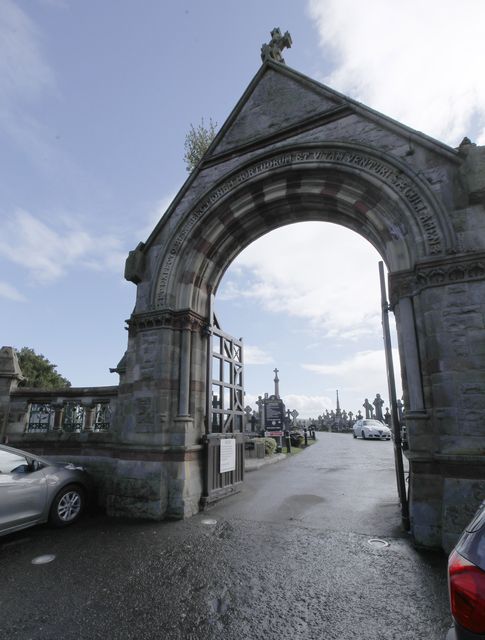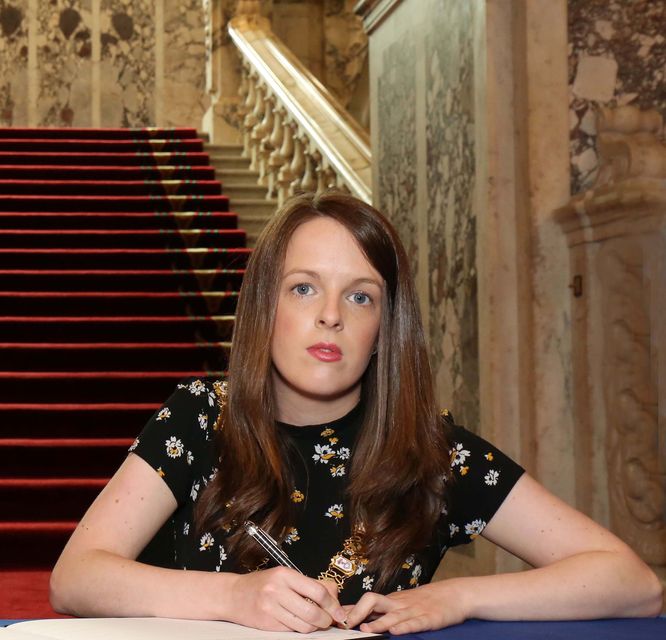Campaigners claim work at Belfast’s best-known graveyard is disturbing the unmarked graves of countless “forgotten” people.
The Catholic diocese in charge of Milltown Cemetery – the final resting place of an estimated 100,000 people – say the work is needed to upgrade the drainage system in the graveyard.
The diocese claims tests have been carried out to ensure the work, which has also included the construction of new paths, does not disturb any unmarked graves.
However, an archaeologist who has carried out extensive research into the history of the cemetery disagrees.
Toni Maguire fears the work being carried at the cemetery has already destroyed many graves.
She said it was important to protect areas of the cemetery where “forgotten” people are buried.
Milltown
“They were the poorest of the poor, nine times out of ten. They didn’t have much in life and they had less in death,” she said.
Ms Maguire and fellow campaigner, Siubhainin Ní Chutnneagam, want the work stopped immediately and a detailed map created of all the graves in the cemetery, where the first burial took place in 1869.
The cemetery is owned by the Catholic Church’s Diocese of Down and Connor and managed on its behalf by a board of trustees.
The area where the current work is being carried out is at the lower end of the graveyard, known as the Bog Meadows.
Toni Maguire, and Siubhainin Ni Chutnneagan (right) pictured in Milltown Cemetery in Belfast
Around six acres of this land was sold by the church to the Ulster Wildlife Trust (UWT) in 2000, but reclaimed nine years later after it emerged there were unmarked burial plots on the site.
The then Bishop of Down and Connor Noel Treanor publicly apologised for the land having been sold.
It has been claimed that up to 11,000 people could be buried without recognition in the lower section of the cemetery.
This includes stillborn babies who were buried in this previously unconsecrated section of the cemetery because they had died before being christened.
Others buried in this section included people who took their own lives or could not afford their own burial plot.
In relation to the current dispute, Fr Eddie McGee, a spokesperson for the Diocese of Down and Connor, said the work at Milltown Cemetery included the upgrading of pathways and the drainage system.
“Before commencing this essential upgrading of drainage and pathways, it was necessary for the trustees to establish if this area of the cemetery had previously been used for burials including baby burials,” said Fr McGee.
Toni Maguire, pictured in Milltown Cemetery in Belfast
“In November 2023, the trustees therefore secured the professional services of Northern Archaeological Consultancy Ltd to investigate this section of the cemetery along the line of paths requiring extension and to investigate potential existing drains or paths long overgrown.
“Having obtained a licence from the Department for Communities (DfC), a number of test excavations were undertaken to provide clarity on the location and extent of unmarked and unlocated burials within this greenfield area of the cemetery.
“DfC confirmed on 3rd April 2024 that all of the Historic Environment Division’s conditions associated with the licence had been met.”
Milltown Cemetery baby burial concerns raised as work continues at the site.
Fr McGee said the archaeological investigation was carried out between November 2023 and February 2024 and its results were compiled in a report publicly available on the diocesan website.
“Informed by these professional archaeological investigations to identify and clearly define the location of all burial sites, including baby burials, within this section of the cemetery, the diocese can therefore provide the assurance that these necessary works will be undertaken with the complete confidence that they will not be located in proximity to or affect known burial sites,” added Fr McGee.
“The professional archaeological investigation undertaken between November 2023 and February 2024 was carried out precisely to ensure that there would be no burials in proximity to pathways and drainage.
“The diocese gives an assurance that no burial sites will be disturbed by these essential works within Milltown Cemetery.”
In 2008, Ms Maguire was asked by Down and Connor diocese to examine the land previously sold to the UWT.
Her work played a key role in the land being reclaimed.
Ms Maguire said she agreed to do the work for no payment on the basis the reclaimed land would never be used again for reburials.
The Lord Mayor of Belfast, Councillor Nuala McAllister
“However, my experiences in dealing with the Catholic Church and religious groups over the past 16 years has proved that their promises don’t always hold water,” she said.
Media reports from 1980 show Milltown Cemetery was then at capacity and nearing closure.
Despite this, Ms Maguire said the church has continued to sell new burial plots.
“I thought this land was safe, it was protected and the church was going to honour the promises they had made.
“Late last year I spoke to someone who happened to mention just casually that their parents had bought a grave in Milltown Cemetery.
“I thought ‘but there are no new graves, there is no ground in Milltown Cemetery for sale’.
“The cemetery was actually closed in 1980 because there were no new graves.
“But what happens is the cemetery seems to close and maybe a decade or so it will open again and there will be an announcement ‘we have found new land’.
“There is no new land in Milltown Cemetery,” added Ms Maguire.
She recently outlined her concerns around the disturbing of unmarked graves at Milltown to members of the Committee for the Executive at the Northern Ireland Assembly.
“I have dealt now since 2008 with Milltown Cemetery,” she told the committee.
“Because I came into that particular research on behalf of the diocese I had access to the records for roughly about six weeks.
“When the diocese suddenly realised just how big the issue of marginalised burials in mass graves in Milltown Cemetery was, the records were withdrawn.
“I had to then resort to finding records and information elsewhere.
“PRONI (Public Record Office of Northern Ireland) was my main source, but there are still major issues with this idea of marginalised infant burials.
“In Milltown, for instance, there is a grave that is recorded in the registers, LM59.
“LM59 was opened in 1957 and contains nine individuals, three women and six babies.
“According to the graded system in Milltown Cemetery as it stands today, LM59 does not exist.
“Where is LM59? Where are all the other graves that gravediggers have said to us ‘there were loads of graves at the section where LM59 is?’
“There are far too many questions and far too few answers.”
Fr McGee said the diocese would also welcome the opportunity to speak to the Stormont committee.
“It is clear from the Hansard transcript that the presentation in relation to works being undertaken within Milltown Cemetery to the NI Assembly committee on 19th June 2024 was informed exclusively by third party sources,” he said.
“The Trustees and Administration of Milltown Cemetery, informed by professional archaeological investigations and accurate cemetery records, would therefore welcome an opportunity to engage with the Assembly committee to bring clarification to the issues discussed around Milltown Cemetery.”
Ms Ní Chutnneagam, who has relatives buried in the lower section of Milltown Cemetery, is also appealing for the current work to be halted.
She said the cemetery “belongs to the people of Belfast” and unmarked graves need to be protected and recognised.
“They have never produced a map of the burial plots in that land. The only records available to the public are from 1937 up to the 1990s. Anything before that has disappeared.
“There are maps but we don’t know go to where to find them.
“For the 37 acres at the bottom of the cemetery, a map has never been produced showing where the individual graves are located.
“We have no doubt the location of the ongoing work is on the site of unmarked graves.”
Earlier this year, Alliance MLA Nuala McAlister said she believed three of her siblings are buried in unmarked graves in Milltown Cemetery.
The North Belfast MLA said her mother lost a baby boy at birth and twins during pregnancy, with the remains of all three children being taken to Milltown.
Ms McAlister said her family cannot be certain where her siblings are buried, but believe they could be buried in the lower section of the graveyard.
She also has called for the drainage work to stop and has submitted a Private Member’s Bill proposal at Stormont which would ensure privately-run cemeteries such as Milltown are subject to the same regulations as council-owned cemeteries.
